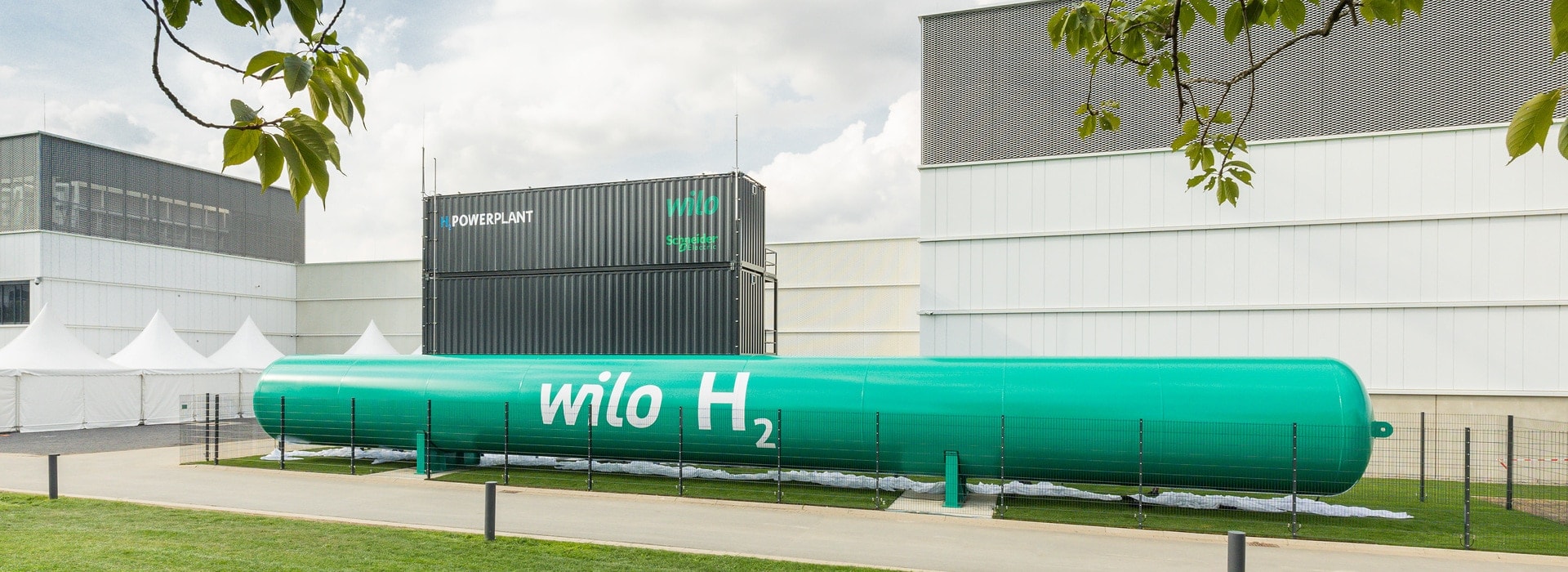H2POWERPLANT – Energy transition made in Dortmund
The H2POWERPLANT uses electrolysis to convert green solar, wind and hydropower into green hydrogen. When it’s needed, a fuel cell can then be used to convert the hydrogen back into electrical energy. The waste heat is either used in the interconnected system for heating, stored or converted into cooling on site. This sustainable use of all released energy optimises system efficiency. The process relies on the precise configuration of the water-bearing systems in addition to intelligent control of energy and load management.
Regenerative power generation
Energy conversion, energy storage, reconversion
Energy use
Heat generation
Cooling recovery
Independence from power grid
Explore the H2POWERPLANT

The H2POWERPLANT is available in four different versions, which Wilo optimises to meet your needs. According to a fundamental market analysis, the H2POWERPLANT spans the market area between conventional battery storage and the large-scale industrial production of hydrogen. This makes this form of energy supply particularly suitable for residential buildings as well as small and medium-sized businesses. Find the right setup for you quickly and easily with our configurator.
Hydrogen – A global market is emerging
Green hydrogen is the energy source of the future. As a storage medium for solar, wind or hydropower, it is free of carbon dioxide and thus a key technology to achieve the Paris climate goals. In its gaseous form, hydrogen also makes it possible to efficiently store, transport and distribute energy. In this way, hydrogen can connect energy sectors across national borders, helping to contribute to a sustainable global energy system.
Right now, hydrogen covers 2 per cent of global energy needs. In the future, this figure will grow dramatically. It is estimated that hydrogen technologies will create 30 million jobs worldwide by 2050. The projected market potential is 2.1 trillion euros by 2050. A highly dynamic global market with great economic opportunities is emerging – for Wilo as well.
"Hydrogen will replace fossil fuels and make independent energy supply a reality, both for Wilo and Germany as a business location."
Technology of the future: The Wilo H2 strategy
Wilo sees significant market potential in the new segment of hydrogen.
Green hydrogen is fundamental for achieving the climate protection goals agreed in Paris.
Green hydrogen has the potential to strengthen Europe’s international competitive capacity.
As a climate protection company and leading innovator, Wilo has a social responsibility.
Wilo provides solutions to counteract climate change and energy shortages.
Wilo can develop into a global player for the generation, storage, distribution and utilisation of hydrogen.

Wilo along the entire hydrogen value chain
As a climate-protection company, it was natural for the Wilo Group to develop a long-term hydrogen strategy. Wilo products and systems have long been used in numerous renewable technologies, such as wind turbines and biogas plants. And the Wilo portfolio is in demand along the entire hydrogen value chain as well. With the know-how of a multinational technology group and as one of the world’s leading premium suppliers of pumps and pump systems, Wilo aims to become a global player in the generation, storage, distribution and utilisation of hydrogen.
The substance of the future
In just two decades between 2000 to 2020, the share of renewable energies in the total electricity consumption rose from 6 to 46 per cent – a trend that will surely continue. But in order to achieve the crucial Paris climate goals and to slow down climate change, the share must do more than merely continue to grow. There must also be a way to efficiently store, transport and distribute this renewable energy. Green (i.e., carbon-free) hydrogen is at once both the ideal and the essential solution here. Generated from wind, solar or hydropower, it can be used in many ways: for example, in fuel cells to generate electricity and heat, as a raw material in industry, or as a fuel for the transport sector. Hydrogen is the linchpin needed to link the world’s energy sectors and to build a sustainable global energy system. Countries that produce a surplus of green energy can export it as hydrogen – this could be the path toward the global energy transition.
Hydrogen-News
Hydrogen is full of energy!
Chemically, one tonne of hydrogen contains the energy equivalent to 33,330 kilowatt hours. That is the equivalent of the average annual energy consumption of eleven three-person households in an apartment block (without a continuous-flow water heater).
Hydrogen is the most commonly occurring element in the universe. In its bound form, it is a component of practically all organic compounds. It has the lowest atomic mass of all the elements: Fourteen times lighter than air, it is neither toxic nor corrosive nor radioactive; it does not self-ignite, and it burns with a colourless flame that leaves no residue.
Where does hydrogen occur in nature?
Hydrogen (H2) occurs only in bound form, for example, in combination with oxygen (O2) as water (H2O). Other important compounds containing hydrogen, which are known as hydrocarbons, include methane (CH4), the main component of natural gas, and petroleum. In addition, more than half of all known minerals contain hydrogen. In the Earth’s atmosphere, hydrogen occurs in steam.




